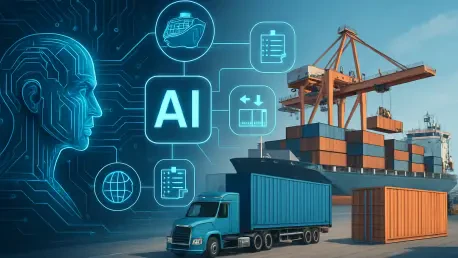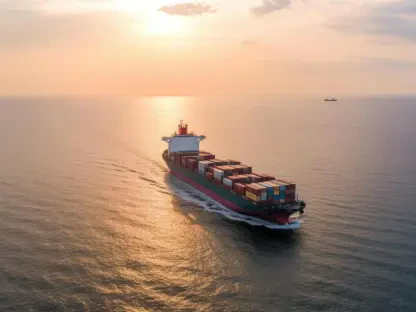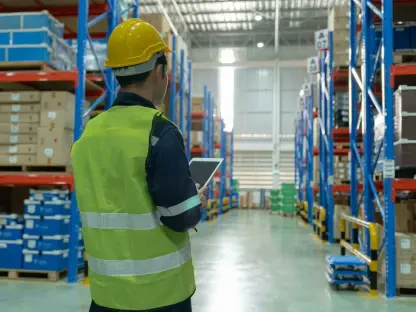Setting the Scene: Why AI Matters in Freight Forwarding
Imagine a logistics landscape where delays are slashed by double-digit percentages, costs are trimmed by millions annually, and customer satisfaction soars—all driven by technology. This is the reality unfolding in the freight forwarding sector as artificial intelligence (AI) takes center stage. In an industry historically plagued by inefficiencies and manual bottlenecks, AI emerges as a transformative force, redefining how goods move across global supply chains. This market analysis delves into the current trends, data-driven impacts, and future trajectories of AI adoption in freight forwarding. The purpose is to provide actionable insights for stakeholders, from small forwarders to global giants, highlighting the strategic importance of embracing this technology amid rising competition and evolving customer demands.
Deep Dive into Market Trends and AI’s Role in Logistics
Current Adoption Patterns: AI as an Efficiency Driver
The freight forwarding market is witnessing a seismic shift as AI integrates into core operations, optimizing everything from routing to warehouse management. Industry benchmarks reveal that AI-driven route optimization, leveraging solver algorithms and machine learning, is cutting fuel consumption and driver hours by 5-15% while enhancing delivery time predictions by up to 25%. Major players like leading logistics firms have reported significant gains, with predictive maintenance reducing vessel downtime by 30% and yielding annual savings in the hundreds of millions. These figures underscore a broader trend: AI is no longer experimental but a proven tool for operational efficiency, reshaping cost structures and service delivery in a highly competitive sector.
Small vs. Large Players: Democratization of Technology
A striking pattern in the market is the accessibility of AI across different scales of operation. While industry titans report massive savings—such as billions annually through inventory management—smaller forwarders are also reaping benefits. Research indicates that affordable AI tools for customs compliance and load matching enable cost reductions of up to 15% and service level improvements of 65% for independent players. This democratization signals a leveling of the playing field, though regional disparities in infrastructure and regulatory readiness pose challenges. The trend suggests that scalability and strategic investment are key to unlocking AI’s potential, regardless of company size.
Challenges Shaping Adoption: Data and Cultural Barriers
Despite the momentum, the market faces notable hurdles in AI integration. Fragmented data systems and inconsistent quality often undermine algorithm accuracy, leading to suboptimal outcomes. Resistance from frontline staff, accustomed to traditional workflows, further complicates deployment, alongside legal uncertainties surrounding automated decision-making. Analysis shows that companies adopting a phased approach—starting with pilot programs and maintaining manual backups—are better positioned to navigate these obstacles. This cautious trend highlights the need for robust data infrastructure and change management to ensure sustainable adoption across the sector.
Future Projections: AI as a Cornerstone of Freight Forwarding
Emerging Innovations on the Horizon
Looking ahead, AI is poised to redefine freight forwarding through cutting-edge advancements. Autonomous vehicles and blockchain integration for supply chain transparency are gaining traction as potential game-changers, promising further efficiency and trust in transactions. Projections suggest that demand forecasting models will become increasingly sophisticated, enabling proactive inventory adjustments and reducing waste. Economic pressures, including fluctuating fuel costs, and regulatory pushes toward sustainability are expected to accelerate these innovations, positioning AI as a critical tool for compliance and cost management in the coming years.
Hybrid Models and Long-Term Competitiveness
Market forecasts point to the rise of hybrid systems combining AI with human oversight as the optimal path forward. Such models address complex logistics challenges while mitigating risks of over-reliance on automation, such as system failures or ethical dilemmas. Speculative insights indicate that within a decade from now, fully autonomous supply chains could emerge, though accountability and legal frameworks remain unresolved. The trajectory is clear: companies investing in AI with a balanced approach will likely dominate market share, while laggards risk obsolescence in an increasingly tech-driven landscape.
Economic and Regulatory Catalysts
Another key projection centers on external factors shaping AI adoption. Rising operational costs and tightening environmental regulations are driving freight forwarders to seek AI solutions for eco-friendly practices, such as optimized routing to lower carbon footprints. Market analysis predicts that from this year to 2027, investment in AI technologies will grow significantly, fueled by government incentives for digital transformation and sustainability. This confluence of economic and regulatory dynamics suggests that AI will not merely be an option but a necessity for maintaining relevance in a rapidly evolving global trade environment.
Reflecting on Insights: Strategic Pathways Forward
Looking back, this analysis illuminates how AI has reshaped freight forwarding by driving efficiency, reducing costs, and enhancing service quality across diverse market segments. The examination of current trends reveals tangible benefits, from fuel savings to improved delivery accuracy, while also acknowledging persistent challenges like data fragmentation and workforce resistance. Projections into the future paint a picture of deeper innovation and hybrid strategies as defining elements of the industry’s evolution. For stakeholders, the path ahead involves prioritizing small-scale pilots in targeted areas like routing or automation, ensuring high-quality data inputs, and fostering staff buy-in through training. By emphasizing measurable outcomes and scalability, companies can position themselves to not only adapt but thrive amid technological disruption, setting a benchmark for resilience and foresight in logistics.









